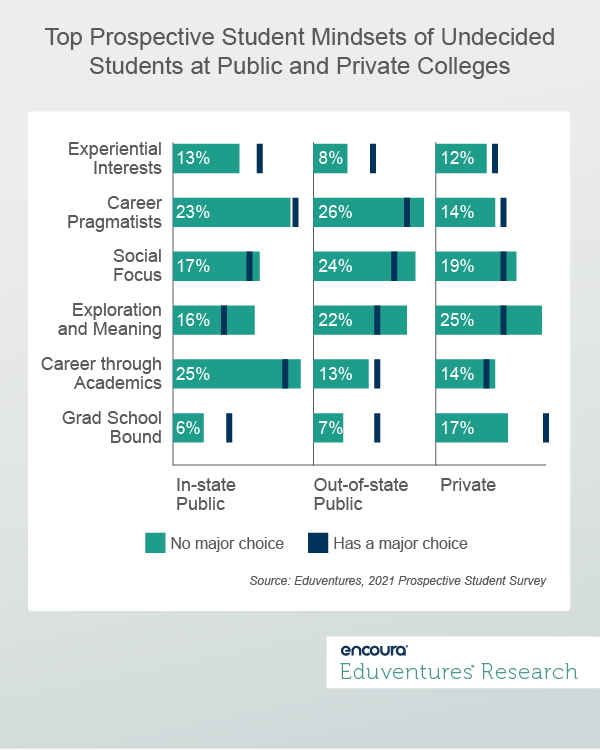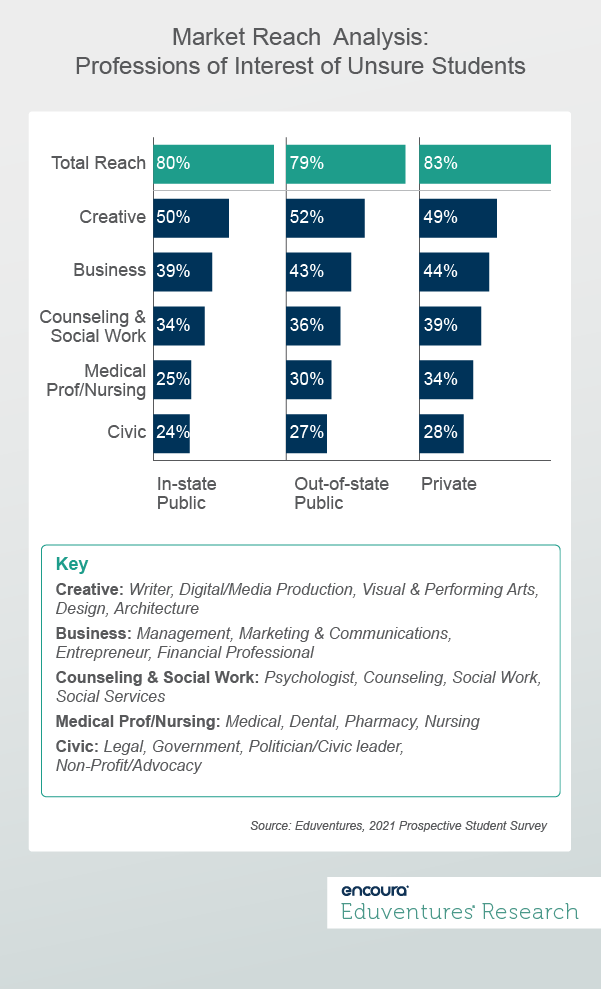Here are three dreaded questions for high school students: Where are you applying to school? What are you going to major in? What do you think you might do with that major? An uncertain student who doesn’t have immediate answers to those questions can easily feel discouraged.
When an uncertain student goes into their college search with no obvious academic programs or crystal-clear career dreams, how can colleges attract their attentions? Eduventures data shows that while they may not feel decisive yet, these students have unspoken or softly spoken ideas. With some insight, colleges can better read the signs, and nurture them through the possibilities.
As recently as 2017, 18% of first-time post-secondary students went into their degree programs as “unsure” or “undecided,” according to the Beginning Postsecondary Students Longitudinal Study. Additionally, the same study indicates that The current COVID enrollment environment may add further uncertainty to the major-career axis of school choice for students.
This data shows the messiness of real life. Many initial major decisions were either deferred until more information could inform a better decision or, if students did have them, they were later adjusted or reversed.
But a high school student approaching the college choice faces a key problem: we live in a culture where decisiveness is considered a strength and indecisiveness comes across as a character flaw. In this case, with the selection of major and the consideration of careers, colleges want to encourage considered thought; initial indecision may actually be a virtue for the student who ends up not choosing a major worth sticking with.
So, what can we learn about the uncertain student who is unsure about what to study? And, how can colleges better work with those students throughout the enrollment cycle?
The Eduventures Prospective Student Research shows that students who are unsure of a college major do think differently than peers who know what they would like to study, but they definitely have pathways in mind. Figure 1 segments these “unsure” students based on Mindset and compares these to those who have made their major choices.

Across the board, uncertain students who are unsure of their major choices are more likely to be Exploration and Meaning students, regardless of the type of institution they are likely to attend. They are also far less likely to be Grad School Bound students. Students likely to attend public institutions (either in-state or out-of-state) are considerably less likely to want to follow the hands-on path of an Experiential Interest student.
The result is that public institutions will see “unsure” in-state students largely identify as Career Pragmatist and Career through Academics Mindsets. For their out-of-state students, they’ll see them oriented as Exploration and Meaning, and Social Focus students, as well as Career through Academics. In comparison, “decided” majors at public institutions are more likely to identify as Experiential Interest and Graduate School Bound students than “unsure” students. Private institutions will see most “unsure” students identify as Exploration and Meaning students but also some as Social Focus and Grad School Bound. Yet many more “decided” students at private institutions are Grad School Bound than “unsure” students.
So, what do students who are “unsure” of their academic majors want to be when they enter adulthood? When we asked them which professions they might consider, we discovered a number of preferences that can be used by institutions to draw these students in. First, on average, “unsure” students consider 3.9 professions compared to 2.8 for students who have a major in mind. Therefore, as we might expect, their options are more open, both academically and professionally. But their professional interests can provide insight into their potential academic interests.
Figure 2 groups the professional interests of “unsure” students by the type of school they might attend.

Our analysis of total market reach shows, by type of institution the student is most likely to attend, the percentage of students interested in any one of the top five profession groups. For example, if a public institution talks about creative, business, counseling and social work, medical professions and nursing, and civic professions, it will meet the interests of 80% of “unsure” in-state students – but creative pursuits are most important. A similar pattern exists for “unsure” students likely headed for out-of-state public and private institutions. You can reach approximately 80% of the unsure market by talking about helping students explore five professional domains with the creative domain being the most important domain.
Beyond the creative domain, these “unsure” students have a common interest in business and counseling and social work, regardless of institutional destination. We begin to see differentiation in professional interests for “unsure” students in other areas. For example, “unsure” students likely to attend private institutions elevate civic professions as an interest more than those interested in public schools. Likewise, natural/life science careers are on the table for students considering private colleges. In some sense, this gives the impression of “unsure” students questioning whether they can be creative or whether they must choose a more realistic major.
In comparison to the overall “decided” population, the interest in creative careers drops from around 50% for “unsure” students to 28% for “decided” students. Many more professions vie for top interest with medical professional and nursing just edging out creative for the overall top spot at 30%. Of course, in the “decided” population, majors can be strongly articulated to career interests. For example, 84% of students interested in computer science are interested in a career in engineering and technology; 92% of students interested in business are interested in a career in business.
The Bottom Line
Institutions should fundamentally validate and support “unsure” students in their quests to explore academic majors. In fact, the environment the school provides for robust major and career exploration might make all the difference to a student who is taking the time to make a good decision.
You can do this by:
- Telling their stories. Provide real stories of unsure students who found their majors and their careers at your institution. But the devil is in the details – highlight the specific curricular and co-curricular experiences that revealed their interests along the way.
- Tailoring engagement & events. Engage students in major and career exploration prior to admissions and help them understand what will be available upon enrollment. Create virtual events just for undecided students to explore options and meet students who have found their paths.
- Personalizing your language. Communicate with “unsure” students using the kind of language that corresponds to the Mindsets in play at your institution. For a student who is most likely to attend a private school, that means Exploration and Meaning and Social Focus. For in-state public students, that means Career Pragmatists and Career through Academics.
- Highlighting the most likely majors. Showcase majors in creative, business, counseling & sociology, and other appropriate academic areas for unsure students. Even if they aren’t ready to decide now, they’ll know the options are excellent.
- Connecting them with like-minded students. Personalize the experience by connecting “unsure” students with current students in these potential majors. They’ll build confidence in either selecting a major prior to admission or coming into your institution with the knowledge that they will have advisory support to select a major in the future.
Never Miss Your Wake-Up Call
Learn more about our team of expert research analysts here.
Eduventures Principal Analyst at Encoura
Contact
Tuesday, November 9, 2021
Colleges and universities seeking to improve the effectiveness of their transfer student marketing intuitively know that not all transfer students are the same. To be successful, enrollment offices must use a persona-based approach to recruit transfer students.
The most recent Eduventures Transfer Student Research reveals the six distinct types of transfer students every admissions office should be well-acquainted with. Join Eduventures Senior Analyst Johanna Trovato as she breaks down the latest findings into practical insights you can immediately apply to your transfer student marketing strategy.
- Who are the six Transfer Student Types?
- What motivates them?
- When does each Type consider transferring schools?
- What are each Type’s top college search sources?
Enrollment offices can use these findings to make more informed decisions about their transfer student marketing strategies, ultimately helping them best support and engage each Type of transfer student along their education journeys.
